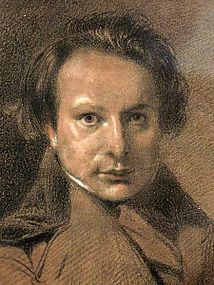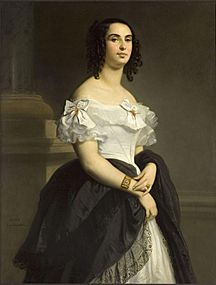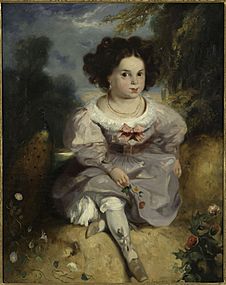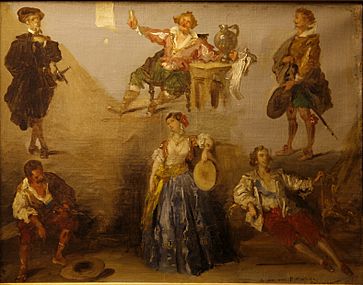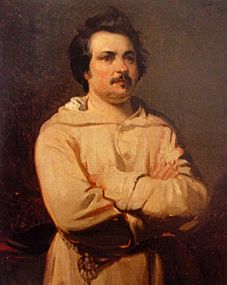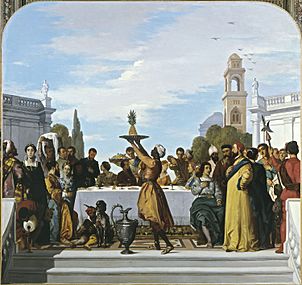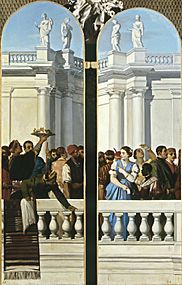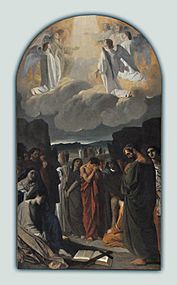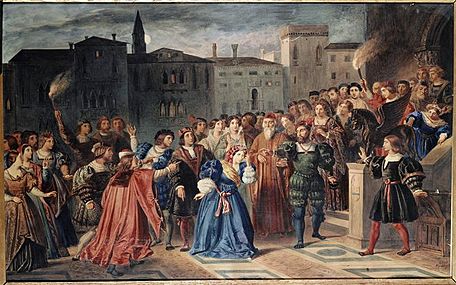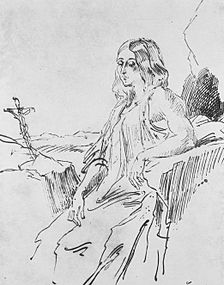Louis Boulanger facts for kids
Quick facts for kids
Louis Candide Boulanger
|
|
|---|---|
| Born | 11 March 1806 |
| Died | 5 March 1867 (aged 60) |
| Alma mater | École nationale supérieure des beaux-arts |
| Known for | Paintings, lithographies, illustrations, scenography, poetry. |
Louis Candide Boulanger (1806 – 1867) was a French artist. He was a Romantic painter, who also worked with pastels and lithography. He was even a poet! Boulanger was known for his paintings of religious stories, symbolic ideas, and everyday life. He also painted many portraits of people.
Contents
Life of Louis Boulanger
Louis Boulanger was born in Piedmont, Italy, in 1806. His father, François-Louis Boulanger, was a soldier in Napoleon's army. His mother was Marie-Magdeleine-Gertrude Archibbuggi.
Early Art Training
In 1821, Louis joined the École des Beaux-Arts, a famous art school. There, he learned a classical style of painting from Guillaume Guillon Lethière. He also became good friends with another artist, Achille Devéria. Louis decided to become a painter because he was inspired by the leaders of the Romantic art movement.
In 1824, he was one of the top students in the Prix de Rome competition. This is a special award for art students. Around this time, he met the famous writer Victor Hugo, who became his lifelong friend.
Later Life and Family
In 1827, Louis and his family moved to a new home in Paris. His hard work paid off, and in 1840, he received the Legion of Honor award. This is a very important award in France.
In 1856, when he was 50, Louis married Adélaïde Catherine Amélie Lemonnier-Delafosse. She was 27 years old. They had two sons together.
In 1860, Louis became the director of the École Impériale des Beaux-Arts in Dijon. This school is now called the École nationale supérieure d'art de Dijon. He passed away in Dijon in 1867. He is buried in Paris.
After Louis died, Victor Hugo wrote a letter to his wife. He said, "I owe Louis Boulanger my best memories. We grew up together. Even when I was a teenager, I could see how talented he was."
Louis Boulanger's Career
Louis Boulanger had many famous friends. These included Victor Hugo, the painter Eugène Devéria, and the writer Honoré de Balzac. Other friends were the poet Aloysius Bertrand and the novelist Alexandre Dumas fils.
Art and Illustrations
In 1827, Louis and his friend Devéria helped illustrate a book about English theater in Paris. That same year, he won a second-class medal from the École des Beaux-Arts. He later won a first-class medal in 1836 and a special cross award in 1840.
Louis loved to travel and learn. In 1829, he visited Germany. In 1831, he went to England with some friends to see museums and churches. He kept detailed journals about his trips.
He created illustrations for many popular books of his time. He illustrated "Les Orientales" (1827) by Alexandre Dumas. He also illustrated seven different editions of "The Hunchback of Notre-Dame" (1836) by Victor Hugo. Both Hugo and Boulanger loved stories about knights, dragons, and medieval times.
Louis also designed costumes for some of Victor Hugo's plays. These included "Hernani" in 1829, "Ruy Blas" in 1838, and "Les Burgraves" in 1843.
Changes in Style
Around 1835, Louis's painting style began to change. He moved away from pure Romanticism. He started focusing on more detailed designs. He found inspiration in old classical stories. During this time, he painted most of his famous portraits.
In 1846, he traveled to Spain with Dumas and other friends. They visited many cities like Toledo and Granada. In Madrid, they went to the Prado Museum. Louis was very impressed by the works of famous painters like Goya, Velázquez, and Rubens. After this trip, his style changed again. He started exploring more Romantic painting techniques.
Major Art Projects
In 1850, Louis Boulanger painted the chapel of the Souls of Purgatory at Saint-Roch, Paris. He also painted a "Torment of St-Laurent" in the Saint-Laurent church in Paris. He created large mural paintings for other important buildings. These included the Palace of Versailles, the Senate chamber at the Luxembourg Palace, and the Palace de Saint-Cloud.
Louis Boulanger's Legacy
Louis Boulanger played an important part in the Romantic Movement in art. He painted portraits of many famous people. These included the writer George Sand, Victor Hugo, and Hugo's wife, Adèle Foucher.
Other artists influenced his paintings. He was inspired by French painters like Antoine-Jean Gros and Eugène Fromentin. He also learned from the English painter John Constable. Later in his life, the Spanish painter Francisco Goya influenced him.
Some people thought his paintings were too much like stories. However, his pastel sky studies were very special. They showed new ideas that later painters like Paul Huet and Eugène Boudin would explore.
You can find his artworks in many French museums. These include the Louvre, the Maison de Victor Hugo, and the Musée des beaux-arts de Tours.
His son, Louis René Boulanger (1860-1917), also became a painter.
Notable Works by Louis Boulanger
- "Supplice de Mazeppa", 1827, his first big success at the Salon, found in the Musée des Beaux-Arts de Rouen
- "The Ronde du Sabbat", 1828
- "La Feu du Ciel", around 1828, at the Maison de Victor Hugo, Paris
- "Les Fantômes", 1829
- "King Leaving for the Town Hall", 1831
- "Assassination of the Duke of Orléans", 1833, at the Musée des beaux-arts de Troyes
- "Petrarch’s Triumph", 1836
- "Portrait of Honoré de Balzac", around 1837
- "Trois amours poétiques: Béatrix, Laure, Orsolina", around 1840, at the Musée des Augustins, Toulouse
- "Notre-Dame de Pitié", 1844
- "Dante's inferno", 1850
- "St Jerome and the Roman Fugitives", 1855
- "Adélaïde Boulanger, née Lemoinier-Delafosse (1829-after 1900), wife of the artist", 1858, at the Louvre.
- "Virgil’s Georgics", 1864
- "Shoe-lace Seller", 1864
- "Vive la joie", 1866, at the Musée des Beaux-Arts de Dijon.
Gallery
- Paintings by Louis Boulanger
-
George Sand as Mary Magdalene in the desert
See also
 In Spanish: Louis Boulanger para niños
In Spanish: Louis Boulanger para niños


